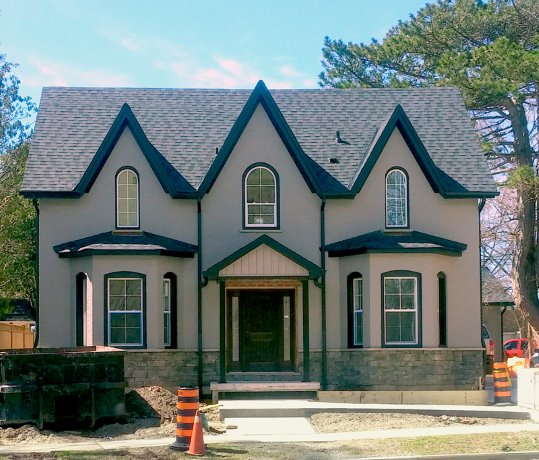In the early spring sunshine, the stately grey house with new lower stone fascia looks like so many other Burlington, Ont. homes around it, full of history with dozens of stories untold and ready to go up for sale.
However, this old house on Maple Avenue, just north of Lakeshore Road, has 150 years of stories to tell, the most recent being how a devoted effort by the city and residents saved it from the wrecking ball at its original location at Elgin and Locust streets.
It’s also the story of how the home standing on the space it now sits on was sacrificed so history could be saved.
The house standing today is known as the David Bastedo house, which dates back to 1880 when most of Burlington was farmland.
The Bastedos were among Burlington’s earliest settlers. Gilbert Bastedo arrived from New York State as a Loyalist in 1794, leaving 32 grandchildren and five great grandchildren in 1865.
The house sat on a choice lot in the heart of Burlington across from the Burlington Performing Arts Centre. Landform Development Group acquired the property and tabled plans to build The Saxony, a "five star" condo with 37 suites over four floors, targeting upscale buyers.
However, it would require demolition of the Bastedo house and that’s where the community drew the line. In their view, demolishing the house would destroy an important part of the city’s history.
As Derek Martin, president of Landform notes, the house wasn’t initially designated under the Ontario Heritage Act, but he could see local politicians and residents rallying for the cause.
"We could have fought it I suppose and we might have won," he says. "But in the end we chose the path of least resistance."
Discretion turned out to be the prudent option.
"The community and city staff made it clear we wanted to preserve the house and we were prepared to work very hard to make sure that happened," says Burlington councillor Marianne Meed Ward, who was instrumental in leading the charge."This is an important building."
With the city moving quickly to designate the house under the Ontario Heritage Act, the two sides started to look at other options. Central Burlington is peppered with Victorian and Edwardian-era homes and there were fears if they lost the fight over the Bastedo house, other homes would follow, says Meed Ward.
She credits Martin with seeing that collaboration was the better option.
At one point Landform considered building around it or incorporating it into the condo design, but it was quickly dismissed because it wouldn’t work with the design premise of the condo.
Landform eventually found a property on Maple Avenue at the end of Elgin Street some 650 metres due west.
They acquired it and demolished the previous home, preparing the site to receive the Bastedo house.
The process started around 2014 with the original Bastedo property acquisition and the final move took place in February 2016 with weeks of planning and site preparation.
"Once we got it on the trailer it was only about 30 minutes to get there, though we were delayed 30 minutes while they moved some wiring," says Cec Abra of Cec Abra Moving based in Branchton, Ont.
"We’ll only take jobs we know we can do. With brick houses, of course, you can’t let them flex at all," he says.
On arrival the house was parked in front and it took six men working five days to install crib piles to support the house as it slid into place.
"We must have had 1,500 pieces in those crib piles," he says. "You always hope to get it in within a few inches and I didn’t believe it at the time but when we rolled it in, it was within two inches. We used the jacks to get it set."
He says moving historic homes is no picnic. The cost is astronomical, he says, because, every step has to be signed off by a heritage qualified architect.
"Even your trades have to be heritage certified which makes them three times more expensive," he says. "It’s stressful too."
The bonus, however, was that his mentor, Charlie Matthews, 87, whom with his brother Roger Matthews were third generation house movers, paid a surprise visit to check things out.
"It was nice because we always sought advice from him," he says, noting Charlie passed away last year.
It took another year of work to renovate inside and out and to repair some minor cracking as would be expected from an old house being physically moved.
The costs, of course, were substantially higher than a simple demolition contract would have been, but Martin is optimistic it will go to budget as planned.
"We’ve done substantial work on the house," he says. "We put in a full basement, we’ve brought it up to standard throughout and added an extension on the back."
The real estate agent hasn’t priced the property yet but Martin expects it to list around $1 million or more.
"We’ll never make back the cost of moving it from the sale," he says. "But overall with the condominium we should break even at least. That’s the plan anyway."
From the community point of view, Landform earned itself substantial goodwill with the decision to move, not demolish.
"Demolition is always going to be easier and cheaper for developers," notes Meed Ward. "We know heritage homes are expensive to preserve. We’re working with the carrot and not the stick of legislation. We want to ease the costs with grant programs such as a $15,000 grant for renovations."
The alternative is losing history, which is invaluable, she says.






Recent Comments
comments for this post are closed